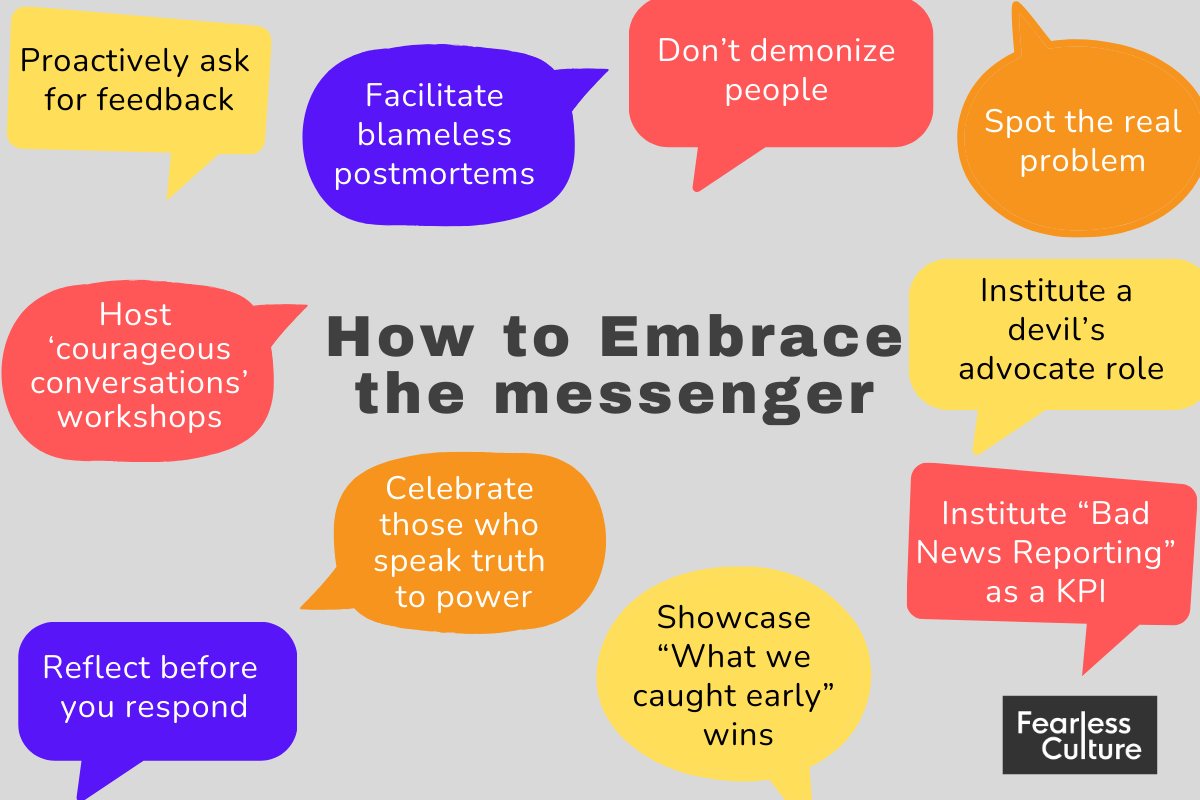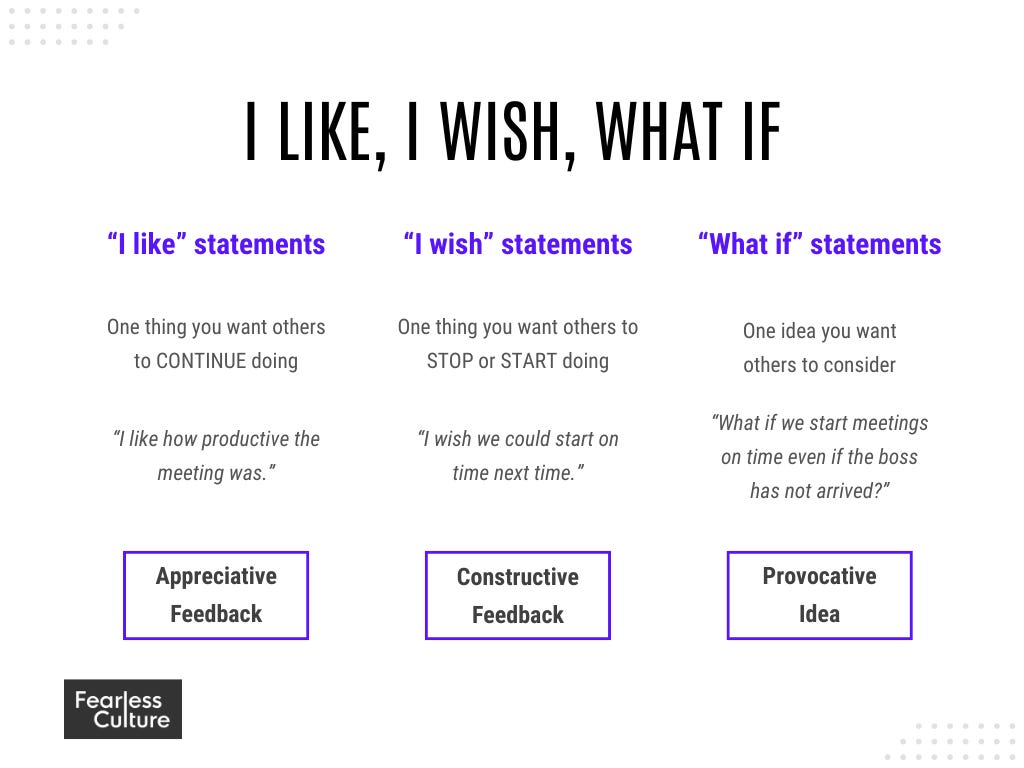How to Deliver Bad News Without Becoming the Scapegoat
Leaders often shoot the messenger, especially when the news is unwelcome. Here’s how to build a speak-up culture – and coach employees to deliver hard truths without becoming outcasts
For more on how to facilitate courageous conversations and foster a culture where people speak up, check out my intensive course, How to Build a Fearless Culture Program.
Leaders have never welcomed bad news. In ancient courts, those returning with grim battlefield reports risked losing their lives, as if killing the messenger would somehow change reality.
Fast-forward to today: We’ve swapped thrones for board chairs, but the impulse to punish those who deliver bad news still permeates the workplace.
“You can kill the messenger, but not the message.”
Today’s messengers aren’t delivering news of lost battles but project delays or customer complaints. And yet, their fate feels just as brutal — a career death by a thousand cuts of blame, silence, or subtle isolation. This culture of denial comes at a steep cost, with companies losing billions as employees stay silent.
So, how can you create a culture that welcomes, rather than punishes, messengers?
The Psychological Weight of Speaking Up
In my consulting work, I always want to start by digging into the root cause before proposing solutions. However, if you already understand what’s happening in your organization or simply want to jump into the recommendations, scroll down to the next section.
Our tendency to avoid bad news is rooted in deep fears and biases. Let’s explore the five most common factors I observe in organizations – and how they promote a culture of silence.
The Ostrich Effect: Avoidance doesn’t make problems disappear
Behavioral economics research shows that we often avoid negative information, especially feedback that could help us monitor our goal progress. Instead, we prefer to stick our heads in the sand, thus the name Ostrich Effect.
For example, 20% of people involved in weight loss programs had never weighed themselves.
Avoidance often makes things worse for leaders, who continue to double down on bad decisions. They become so anxious about the possibility that their beliefs or assumptions are wrong that they ignore facts or data.
A postmortem of Nokia’s fall uncovered a fear-based culture that discouraged employees from delivering bad news. Consequently, middle managers filtered information, providing overly optimistic reports and even manipulating data.
Loss Aversion: Silencing bad news to avoid pain
The pain of loss is more intense than the pleasure of an equivalent gain. Research by Nobel Prize winner Daniel Kahneman and Amos Tversky shows that we are twice as likely to avoid losses as we are to pursue gains.
Loss aversion makes leaders ignore critical feedback. This is even more evident when the news implies setbacks to projects they’ve championed.
BlackBerry's early decline perfectly illustrates loss aversion. When employees warned of the iPhone's competitive threat, leaders dismissed it, driven by fear of ‘reputational loss.’ Admitting flaws in their core model felt riskier than staying the course – a mistake that rapidly eroded market share.
The Messenger’s Dilemma: Social risk silences critical feedback
Many employees avoid speaking truth to power due to social risk – they fear being singled out as “difficult” or “negative.” Even well-meaning employees often find themselves reluctant to speak up, worrying they’ll be accused of not being a team player.
A Gallup study reveals that although 9 out of 10 employees say they would report unethical behavior, only 4 actually do. Instead, they look the other way, remain silent, or disengage entirely.
For many years, Uber claimed to have a culture of openness and inclusivity. However, when many female employees reported sexual harassment, they were silenced and told it was “his first offense” – even after multiple complaints about the same manager. It took an investigation by a former U.S. Attorney General to reveal Uber’s prevalent retaliation culture.
Cycle of Silence: Defensiveness discourages constructive feedback
When leaders react defensively to feedback, they inadvertently create a silence loop. Not only do they signal that they aren’t open to feedback, but they also indicate that they don’t care. Why continue sharing feedback if there’s no action?
According to a Leadership Study, too few leaders are open to feedback from their teams. Only 24% of people say their leaders always encourage and act upon suggestions for improvement.
A silence loop doesn’t just harm individuals – it snowballs, leading to significant breakdowns, as seen in Boeing’s 737 Max crisis. Employees voiced concerns about safety issues, but internal pressure to deliver on deadlines prevailed. A later investigation showed that concerns were often downplayed, and leaders dismissed constructive feedback.
Bystander Effect: The rationalization of staying silent
Sometimes, people rationalize their silence by assuming someone else will step in. The bystander effect creates a diffusion of responsibility, causing employees to avoid intervening because they believe someone else will.
Research by the Academy of Management reveals that when multiple employees are aware of an issue, each one becomes less willing to speak up. This bystander effect often leads to a culture of silence.
Volkswagen’s emission scandal wasn’t a surprise to insiders. Most engineers knew about the emissions discrepancies, but many rationalized their inaction. They were expecting someone else to speak up.
Build a Culture That Embraces and Rewards the Messenger
Creating a fearless culture in which honesty thrives requires intentional actions from both leaders and team members, as I explain here.
Let’s start with how you, as a leader, can build a culture that not only tolerates but actively rewards those who speak up.
1. Reflect before you respond
It’s tempting to react to difficult news and dismiss it outright. Before reacting, check if your beliefs are clouding your judgment. Ask yourself: Why am I resisting this information? What truths or assumptions is this news challenging?
Reflecting on your response first will help you approach feedback with curiosity rather than defensiveness. As I wrote in Forbes, resistance to change can be deeply emotional. The loss of certainty, control, or reputation often clouds our judgment, leading us to value the gains.
2. Don’t demonize people
Avoid labeling those with critical perspectives as “negative.” Separate the person from the problem – and always assume positive intent. If people feel you don’t trust them, they will stop bringing up concerns.
Instead of calling them out for being negative, try saying, “I appreciate your interest in helping us get better.” Show appreciation for their opinions, and if you disagree, ask clarifying questions first before jumping into judgment.
Remember the Iceberg of Ignorance: Staff see 100% of issues, while middle managers see only 9%.
3. Spot the real problem
What’s the real issue at hand? Stay focused on the actual problem rather than getting entangled in emotions. Identify the overarching theme behind the news: Is it a surprise you didn’t see coming, competition disruption, market changes, or unrealistic goals?
Reframing the problem brings clarity and shifts the conversation from ‘right or wrong’ to ‘what if?’ When you no longer have the answer, that’s the moment to start working on what comes next.
4. Celebrate those who speak truth to power
Publicly acknowledging and celebrating those who deliver difficult truths sends a powerful signal. It encourages other team members to share their perspectives, even when it’s uncomfortable.
Consider establishing a ‘Truth Matters’ spotlight in your company meetings or newsletters that recognizes those who speak truth to power. Set up a ritual, such as an annual ‘Reality Check Award,’ to celebrate their courage.
5. Proactively ask for feedback
Asking for feedback puts our brains in a reward-oriented state, which means we’re more open to truly listening. When leaders proactively ask for feedback, they create a vulnerability loop. This signals that they’re open to learning and adapting.
But only ask for feedback if you’re willing to act on it. As a leader, you don’t have to implement every suggestion, but you do have the obligation to listen and consider your team’s input. Always follow up to explain why certain changes may or may not happen.
6. Institute a devil’s advocate role
Implement a "devil's advocate" role in meetings, designating someone to challenge ideas and identify blind spots. This approach neutralizes groupthink and encourages respectful dissent.
Set clear ground rules and rotate responsibility so everyone has their chance to play the devil’s advocate role.
7. Facilitate regular blameless postmortems
In a blameless culture, mistakes are seen as the results of systemic flaws rather than individual faults. A blameless postmortem sheds light on a project by addressing not just what went wrong but why – without the blame.
Host a blameless postmortem to identify missed opportunities. Reflect with your team, “What early signals did we miss?” “Was any messenger silenced or ignored? Why?”
A blameless postmortem helps shift from “Who’s at fault?” to “How can we learn from this issue?” – and prevent it from happening again.
8. Institute “Bad News Reporting” as a KPI
Turn openness and transparency into a measurable Key Performance Indicator. Track how often leaders solicit and respond to critical feedback.
Here are some thoughts to get you started:
Track the number of one-on-one check-ins leaders have each month
Measure follow-though: the number of suggestions raised by the team versus those acted upon
Conduct quarterly pulse surveys to assess leaders’ openness and active responses to feedback
9. Showcase “What we caught early” wins
Team rituals create a sense of belonging while reinforcing positive behaviors.
Create a “What we caught early” ritual to celebrate wins. For instance, highlight moments where people who spoke up prevented issues from escalating, saved the company money, or allowed the product team to fix a bug before launch.
10. Host ‘courageous conversations’ workshops
Offer workshops to equip your team with the confidence and skills needed to deliver constructive criticism. Facilitating courageous conversations is both a science and an art.
At Fearless Culture, we guide teams through this process in our workshops. By establishing a shared language and frameworks, we turn courageous conversations into a regular, valued practice.
How to Deliver Bad News Without Becoming the Scapegoat
Delivering difficult truths doesn’t have to mean risking one’s credibility or career. Here are some tips to help you navigate tough conversations.
1. Get to the point – and use facts
Getting to the point quickly is crucial. Focusing on lessons and solutions, rather than blame, helps keep emotions in check. Context matters, but too much can trigger leaders to assume the worst.
Explain the issue, sticking to the point – the more details, the more anxious leaders may get.
Support your feedback with specific, up-to-date data to keep the focus on facts rather than feelings. For instance, instead of saying, “Our clients are unhappy,” say, “Our customer satisfaction scores have declined by 20% this quarter. We need to turn that around!”
2. Focus on what needs to happen
Share the issue concisely: What’s the headline? Then, steer the conversation toward what needs to happen. Instead of saying, “We’re behind schedule,” try, “Now that we’re behind schedule, where would our resources be best allocated to meet critical milestones?”
Framing it as a shared challenge shows your commitment to finding solutions, not just pointing out issues.
3. Choose the right timing
Timing is crucial for delivering difficult news effectively. Plan for a moment when your leader is likely to be more receptive. Avoid catching leaders off guard or delivering bad news during high-stress periods.
As a rule of thumb, no one wants to start or finish their day with bad news. Unless it’s urgent, aim to have the conversation when your leader is more likely to be receptive.
When in doubt, ask to schedule time by saying you’d like to discuss something important at their convenience.
4. Present the news with a plan
The “bring solutions, not problems” adage is flawed; it places all the responsibility on employees. It can breed a culture of intimidation and fear. Not every problem has a simple solution – and any leader’s key role is to help their team members succeed.
Nevertheless, presenting a few initial thoughts always comes in handy. These might include alternative solutions, quick fixes, or even thought-provoking questions to kick off the conversation.
Using the “I like, I wish, What if?” framework can help you prepare a few starting points.
5. Acknowledge the emotional response
When leaders receive bad news, they immediately want to blame someone. Don’t let that be you. Instead of taking it personally, validate the leader’s emotional investment.
Show empathy by acknowledging their perspective, especially if they’re deeply involved in the project. Saying something like, “I know how important this project is to you, and I appreciate the effort that’s gone into it,” helps reduce defensiveness and demonstrates respect for their work.
6. Own your part
Taking responsibility is essential to build trust and set a constructive tone. Acknowledge any role you or your team may have had in the situation. This doesn’t mean over-apologizing; rather, it’s about taking ownership.
For instance, instead of deflecting with, “The project fell behind because of external delays,” try saying, “We've had some setbacks that have impacted our progress, and here’s what we’re doing to get back on track.”
This approach demonstrates that you’re not just passing the problem up the chain – you’re actively engaged in resolving it.
7. Engage leaders with open-ended questions
Rather than simply reporting a problem, use powerful questions to invite problem solving. For example, “What’s your perspective on how we should approach this?” or “In light of the situation, where do you think we should focus next?”
This approach not only values leaders’ insights but also turns the conversation into a collaborative effort. Leaders who are invited to co-create the solution are more likely to become your ally.
Creating a culture of openness is about more than transparency – it requires courage. By embracing the messenger, you can create an environment where sharing difficult news isn’t just expected but celebrated.
Promote a speak-up culture and coach your team on how to deliver hard truths. This will help you turn bad news into opportunities for growth and innovation.
Contact me to keynote at your next event, or schedule a free consultation to discuss how I can help your organization build a fearless culture.







